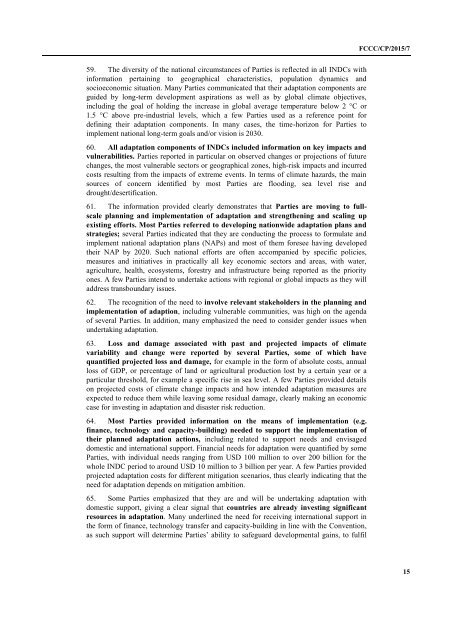FCCC/CP/2015/7
1PYuHQM
1PYuHQM
You also want an ePaper? Increase the reach of your titles
YUMPU automatically turns print PDFs into web optimized ePapers that Google loves.
<strong>FCCC</strong>/<strong>CP</strong>/<strong>2015</strong>/7<br />
59. The diversity of the national circumstances of Parties is reflected in all INDCs with<br />
information pertaining to geographical characteristics, population dynamics and<br />
socioeconomic situation. Many Parties communicated that their adaptation components are<br />
guided by long-term development aspirations as well as by global climate objectives,<br />
including the goal of holding the increase in global average temperature below 2 °C or<br />
1.5 °C above pre-industrial levels, which a few Parties used as a reference point for<br />
defining their adaptation components. In many cases, the time-horizon for Parties to<br />
implement national long-term goals and/or vision is 2030.<br />
60. All adaptation components of INDCs included information on key impacts and<br />
vulnerabilities. Parties reported in particular on observed changes or projections of future<br />
changes, the most vulnerable sectors or geographical zones, high-risk impacts and incurred<br />
costs resulting from the impacts of extreme events. In terms of climate hazards, the main<br />
sources of concern identified by most Parties are flooding, sea level rise and<br />
drought/desertification.<br />
61. The information provided clearly demonstrates that Parties are moving to fullscale<br />
planning and implementation of adaptation and strengthening and scaling up<br />
existing efforts. Most Parties referred to developing nationwide adaptation plans and<br />
strategies; several Parties indicated that they are conducting the process to formulate and<br />
implement national adaptation plans (NAPs) and most of them foresee having developed<br />
their NAP by 2020. Such national efforts are often accompanied by specific policies,<br />
measures and initiatives in practically all key economic sectors and areas, with water,<br />
agriculture, health, ecosystems, forestry and infrastructure being reported as the priority<br />
ones. A few Parties intend to undertake actions with regional or global impacts as they will<br />
address transboundary issues.<br />
62. The recognition of the need to involve relevant stakeholders in the planning and<br />
implementation of adaption, including vulnerable communities, was high on the agenda<br />
of several Parties. In addition, many emphasized the need to consider gender issues when<br />
undertaking adaptation.<br />
63. Loss and damage associated with past and projected impacts of climate<br />
variability and change were reported by several Parties, some of which have<br />
quantified projected loss and damage, for example in the form of absolute costs, annual<br />
loss of GDP, or percentage of land or agricultural production lost by a certain year or a<br />
particular threshold, for example a specific rise in sea level. A few Parties provided details<br />
on projected costs of climate change impacts and how intended adaptation measures are<br />
expected to reduce them while leaving some residual damage, clearly making an economic<br />
case for investing in adaptation and disaster risk reduction.<br />
64. Most Parties provided information on the means of implementation (e.g.<br />
finance, technology and capacity-building) needed to support the implementation of<br />
their planned adaptation actions, including related to support needs and envisaged<br />
domestic and international support. Financial needs for adaptation were quantified by some<br />
Parties, with individual needs ranging from USD 100 million to over 200 billion for the<br />
whole INDC period to around USD 10 million to 3 billion per year. A few Parties provided<br />
projected adaptation costs for different mitigation scenarios, thus clearly indicating that the<br />
need for adaptation depends on mitigation ambition.<br />
65. Some Parties emphasized that they are and will be undertaking adaptation with<br />
domestic support, giving a clear signal that countries are already investing significant<br />
resources in adaptation. Many underlined the need for receiving international support in<br />
the form of finance, technology transfer and capacity-building in line with the Convention,<br />
as such support will determine Parties’ ability to safeguard developmental gains, to fulfil<br />
15


